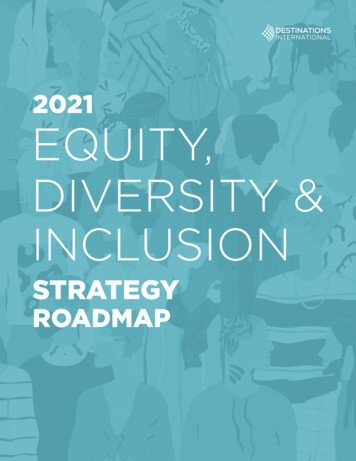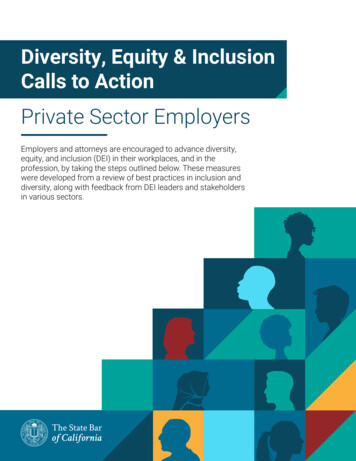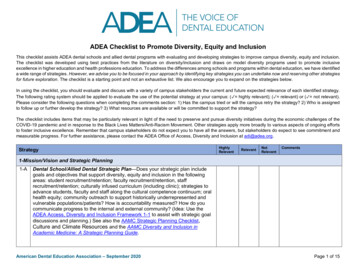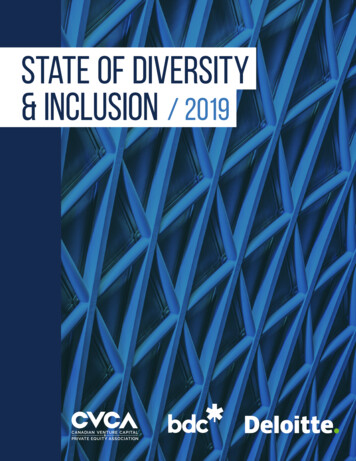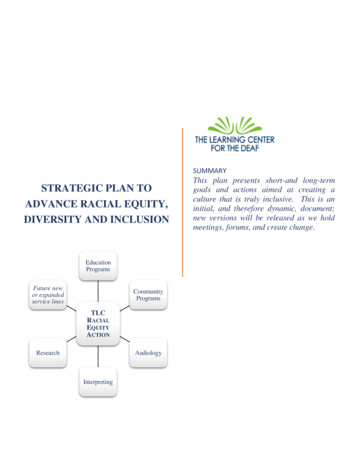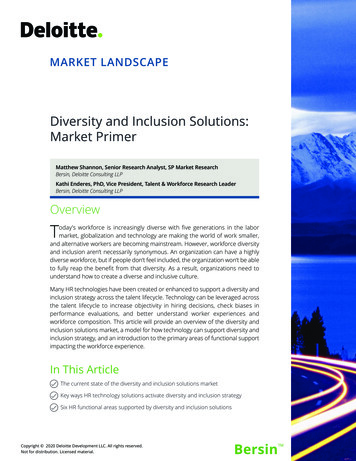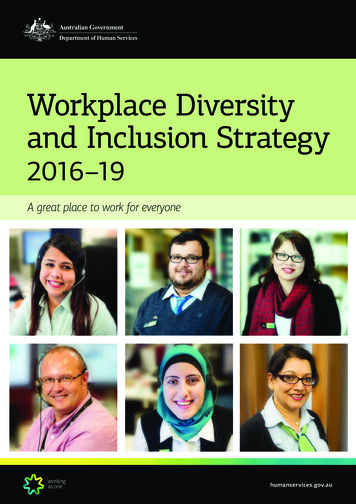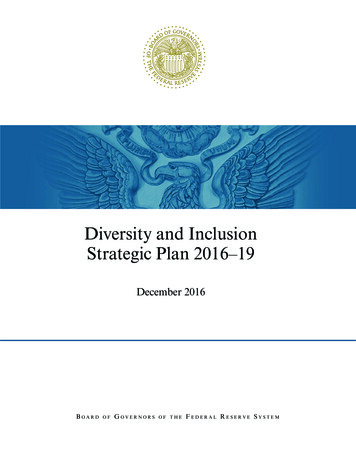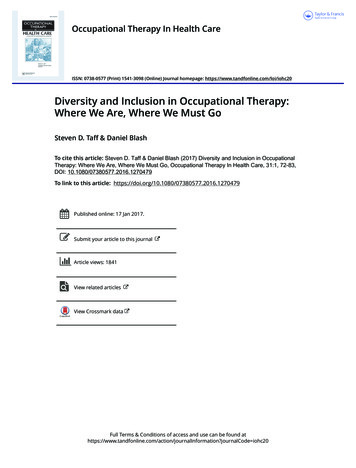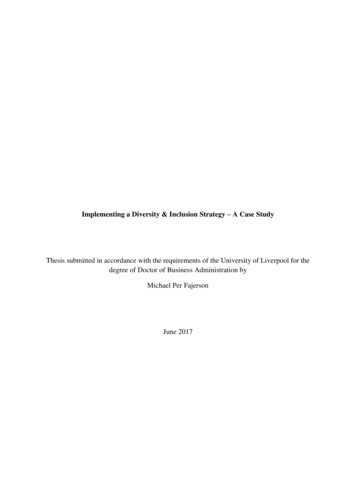
Transcription
Implementing a Diversity & Inclusion Strategy – A Case StudyThesis submitted in accordance with the requirements of the University of Liverpool for thedegree of Doctor of Business Administration byMichael Per FajersonJune 2017
Page 2AbstractCurrent scholar-practitioner literature demonstrates that diversity and inclusion (D&I) arenecessary for organisational performance. All organisational members are needed for aninclusive corporate culture to be genuine.The problem for a large global organisation with Swedish roots was that its D&I strategy hadnot been turned into action as expected. This was evident from discussions with theorganisation’s D&I manager and from the 2014 employee satisfaction survey.The research question of this study was: How can the organisation turn its D&I strategy intoaction?Using a purely qualitative case study design, the research objective of this study was toinvestigate how 18 very diverse middle managers and rank and file employees throughout thisglobal organisation would turn the organisation’s D&I strategy into practical action usingexisting D&I material. Key questions to be answered included how research participants viewthe D&I material provided by the organisation and how they would use it to promote theaction change needed and avoid pitfalls.Data collection and analysis through in-depth, face-to-face interviews coupled with documentanalyses in accordance with the case study methodology (Yin, 2003) provided a rich and thickdescription of the case.Condensing emerging categories into four major themes relating to established theory aspresented in extant literature provided the base for answering research questions. The fourmajor themes were: The Need for D&I, Effective Awareness-Building, EffectiveImplementation, and Effective Conflict-Handling.Identifying researcher bias, member checking, and triangulation established trustworthiness.Key findings included that the organisation’s D&I material were useful and globally valid. Itcould be used to build awareness and promote action change. Drawbacks with D&I can behandled. Middle management is the key employee group to turn strategy into practical actionin the workplace.Actionable knowledge derived from the findings was the detailed recommendation for turningthe D&I strategy into practical action throughout the entire organisation. Implementing therecommendation could be swift, decentralised, and organization-wide. Middle managers, asthe key change agents, would drive action and change in the D&I area to achieve a sustainableorganisational inclusive culture. Other organisations could use the recommendation to achieveaction change.
Page 3DedicationThis thesis is dedicated to my aunt Birgitta who passed away far too young some ten yearsago. She whole-heartedly supported all the many educational endeavours that I engaged inover the years. She would have been proud to see that I have now reached the end of myUniversity of Liverpool Doctor of Business Administration journey.
Page 4AcknowledgementsI would like to thank the following people for their part in making my overall University ofLiverpool DBA experience a great one and, in particular, for all their help making the finalstage - this thesis – a successful experience.1. Above all, the 18 anonymous participants for their time and effort in order to help merealise my research project and complete this thesis,2. Dr Lisa Anderson at the University of Liverpool for - together with her colleagues creating an excellent DBA programme back in 2010 that so well fit my needs andinterests and who ensured that it also was accredited by the AACSB in 2012 – truth isthat the University of Liverpool DBA experience has been the best educationalexperience of my entire life,3. Dr Kenneth Simpson, my very first professor on the University of Liverpool DBAprogramme for his excellent on-line teaching skills, encouragement, and dedicationwhich greatly inspired me and made my DBA experience an extra-ordinary one fromthe very beginning,4. Dr James Pounder, my primary thesis supervisor, for his interest, support and goodideas generated during our regular Skype meetings and e-mail contact,5. Dr David Higgins, my secondary thesis supervisor, for his support and good adviceduring the latter part of my thesis report writing,6. Elaine Schiavone, Business Development Executive, IBM Workforce Diversity &LGBT Markets, for our inspiring diversity and inclusion discussions that - in the end put my thesis deliberations on the right track,7. Dr William A. Guillory, President of Innovations International, Inc., for his inspiringsupport during the different stages of my research study,8. Annamaria Szilagyi for her efficient work as student support manager during the firstpart of the DBA programme and all the help and support she afforded me, especiallyin organising the two residency meetings in Liverpool in 2013,9. Anna Hedebrant and Malin Rogström at Sandvik for their organisational support andinterest in my DBA thesis, especially from the viewpoint that it is very much related tothe on-going Sandvik effort to enhance its inclusive organisational culture,
Page 510. Gérard Dequet and Marie-Louise Ek, both formerly with Sandvik, for their initialsupport and their continued interest in - and follow-up of – the development of myDBA courses and this thesis.
Page 6Table of ContentsDedication3Acknowledgements4Chapter 1 – Introduction91.1 The Importance of Diversity and Inclusion91.2 Definition of Diversity and Inclusion101.3 Innovation and Business Performance101.4 The Present Research Study121.5 The Importance of Diversity and Inclusion at Sandvik131.6 Context of the Study141.6.1 The General Context141.6.2 The Sandvik Context141.6.3 The Personal Context161.7 Structure of the ThesisChapter 2 – Literature Review17172.1 Overview172.2 Concepts of Diversity and Inclusion (Differences and Interrelations)192.3 Concepts of Diversity and Inclusion (Business Case andParticipation of All)212.4 Concepts of Diversity and Inclusion (Global Implementations)232.5 Concepts of Diversity and Inclusion (Friction and Conflict)262.6 The Present Research in Light of Previous Research28Chapter 3 – Methodology3.1 Background30303.2 Choosing Between a Quantitative and a Qualitative ResearchMethodology343.3 Choosing Between a Case Study and a Phenomenology353.4 Drawbacks when Using a Case Study methodology373.5 Ethical Considerations393.6 Sampling and Selecting413.7 Recruiting and Participant Instructions413.8 Research Participant Backgrounds423.9 Interview Process443.10 Data Collection47
Page 73.11 Data Analysis483.12 Action Research Aspects on Choosing a Research Methodology503.13 Summary50Chapter 4 – Research Findings524.1 Major Theme 1: Need for D&I4.1.1 Common Subtheme 1: Self-Evidence of D&I60604.1.2 Common Subtheme 2: Usefulness of the Material and itsGlobal Validity614.1.3 Common Subtheme 3: Gender Diversity versus Full D&I634.1.4 Common Subtheme 4: Performance Aspects of D&I654.2 Major Theme 2: Effective Awareness-Building664.2.1 Common Subtheme 1: Enjoyment664.2.2 Common Subtheme 2: Creation of Inclusion674.2.3 Common Subtheme 3: Discussion Group Size674.2.4 Common Subtheme 4: Separate Project vs. Part of Daily Life 674.3 Major Theme 3: Effective Implementation4.3.1 Common Subtheme 1: Involvement of All68684.3.2 Common Subtheme 2: Clear Action Plan and Follow-UpMeasures684.3.3 Common Subtheme 3: Use of Discussion Groups694.3.4 Common Subtheme 4: Need for Implementation Time704.3.5 Common Subtheme 5: Copy of EHS Implementation704.3.6 Common Subtheme 6: Problem-Solving Exercises714.4 Major Theme 4: Effective Conflict-Handling714.4.1 Common Subtheme 1: Use of Facilitators714.4.2 Common Subtheme 2: Benefits of Conflict724.4.3 Common Subtheme 3: Use of Feedback Techniques734.4.4 Common Subtheme 4: Need for Additional Decision Time734.5 SummaryChapter 5 – Discussion and Conclusion74755.1 Analytic Generalisation755.2 Recommendation for Sandvik and Implications for Future Practice795.3 Study Limitations845.4 Future Research85
Page 8Chapter 6 – Learning Reflections886.1 Introduction886.2 Learning from Choosing the Research Topic886.3 Learning from the Methodology Selection896.4 Learning from Ethical Considerations906.5 Learning from the Interaction with Research Participants916.6 Learning from the Data Analysis916.7 Learning from the Report Writing926.8 My Role as Change Agent936.9 Summary95Appendix A - Research Participant Information Sheet96Appendix B – Research Participant Consent Form97Appendix C - Interview Protocol98Appendix D - Sandvik’s Business Case for D&I100Appendix E – Sandvik’s Small Acts of Inclusion108Appendix F – Sandvik’s Perspectives on Recruitment109Appendix G – Foreign Language Quotes112Appendix H – Document Review117Appendix I – Video Review118List of References120List of Videos130List of Tables and Illustrations (in order of appearance)Figure 1 – Synopsis of Literature Review and Research Purpose29Table 1 – Response Rating Sandvik Employee Engagement Survey 201432Table 2 – Research Participant Demographics44Table 3 – Interview Questions47Figure 2 – Simplified Data Analysis Model49Figure 3 – Research Steps Towards Forming the Major Themes51Figure 4a - Major Themes53Figure 4b – Awareness-Building Categories54Figure 4c – Conflict-Handling Categories55Figure 4d – Implementation Categories56Figure 4e – Why D&I Categories57Figure 5 – Subthemes Within the Four D&I Major Themes59
Page 91.IntroductionThis introductory chapter begins with a short review of the most important content-relatedissues at stake for this research study. It then presents the research problem, question, andobjective. The chapter also briefly presents the Sandvik organization. This is the organizationwhere this research intervention was conducted. It concludes with the context-related issuespertinent to the study and a brief overview of the thesis layout.1.1The Importance of Diversity and Inclusion (D&I)As the global business world becomes increasingly competitive, businesses require enhancedabilities to innovate and to attract, develop, and retain the talent capable of serving theirdiverse customer base.Procter & Gamble’s CEO, A.G. Lafley (cited in Hyter and Turnock, 2005, p. 1) states that his‘23 years at P&G have convinced [him] that a diverse organisation will out-think, outinnovate, and out-perform a homogeneous organisation every single time’.Scholars largely agree with Lafley. Page (2007), for example, asserts that although diverseteams may not provide any benefit over homogeneous teams regarding routine tasks andsimple problems, they certainly out-perform homogeneous teams regarding the complexproblems that increasingly confront modern organizations.Several research studies show that gender diversity on the company board and at the topmanagement level increases organisational financial performance. Gender diversity is an oftendebated diversity aspect in media today. For example, Campbell and Vera (2009) studiedshort-term stock market impact on announcements of the appointment of female boardmembers to Spanish company boards. They found that stock markets do indeed reactpositively and investors therefore seem to believe that appointing female board members addvalue. Francoeur, Labelle, and Sinclair-Desgagné (2008) studied the effect on firmperformance based on the percentage of women managers. As opposed to Campbell’s andVera’s research findings, stock performance was not influenced in Francoeur, Labelle, andSinclair-Desgagné study. However, Francoeur, Labelle, and Sinclair-Desgagné found thatfirm performance did indeed increase when firms had a high percentage of women inmanagement positions.Cumming, Leung, and Rui (2012) studied how gender diversity on Chinese corporate boardscorrelate with lower incidents of fraud. They found that companies with higher percentages ofwomen board members enjoy lower frequencies and less severe cases of fraud. In addition,these researchers found that stock market response to cases of fraud was less pronounced forcompanies having a high percentage of female directors.Likewise, Brammer, Millington, and Pavelin (2009) studied how corporate reputation in UKfirms correlated with female board member percentages. Their findings show that the firms’stakeholder environment influenced reputation. The researchers found that higher firm
P a g e 10reputation correlates with higher female board member percentages in industries that serveend customers but they found no such correlation in business-to-business industries.Recent research studies indicate that when top management (corporate president and vicepresidents, and board members) have diverse higher education backgrounds and differentnationalities, the financial and non-financial company performance (employee turnover,company reputation, efficient governance, and ethics) will increase. For instance, Nielsen andNielsen (2013) researched how top management diversity (other than gender diversity)affected corporate performance and found that diversity in nationality outperformed bothtenure and firm internationalisation as a cause for higher organisational performance.1.2Definition of Diversity and InclusionDiversity and inclusion (D&I) are inexorably linked. Accordingly, Tapia (2009, p. 12) arguesthat, ‘Diversity is the mix. Inclusion is making the mix work’. While diversity involvesallowing people with diverse backgrounds to participate, inclusion is the actual act ofparticipation. Furthermore, ‘[d]iversity can be mandated and legislated, while inclusion stemsfrom voluntary actions’ (Winters, 2014, p. 206). Diversity refers to the demographiccompositions of teams whereas inclusion measures how well individuals feel appreciated asorganisational members and participants (Robertson, 2006).Based on Shorter-Gooden (2014, p. 453), I ‘use the terms diversity and inclusion to addressissues of composition and full engagement, respectively’ and establish the followingdefinitions for this research study:Diversity regards the composition of teams whereas inclusion regards the engagement of theindividual team members and the overall teams.1.3Innovation and Business PerformanceResearch indicates that diversity in organisational settings is critical because cognitivediversity embedded in an inclusive organisational culture gives rise to the innovation crucialfor business success.Already in 1998, Heunks explored the correlation between innovation and organisationalperformance. He found that there is a clear correlation between innovation and businessperformance.Other examples of research studies confirming that successful innovation leads to betterorganisational performance include Yen’s et al (2012) study which collected data from 312Taiwanese companies to show that service innovation capabilities correlate with a firm’sability to create competitive advantage and increase organisational performance. Theresearchers found that, among other things, the ability to include new employees/ideas is aprerequisite for successful increase of service innovation capabilities.
P a g e 11Likewise, Cantantone, Cavusgil, and Zhao (2002) study how learning orientation affectsorganisational innovativeness and, thus, performance across a broad spectrum of USindustries. The researchers found that knowledge sharing and open-mindedness affect firminnovation and that firm innovation affects firm performance. Their study supports that ‘firminnovativeness is positively related to firm performance’ (p. 522).Love, Roper, and Bryson (2011) in their study of 1,100 UK-based service industries alsofound that innovation is linked to organisational performance. The researchers found thatexternal (knowledge-seeking) and internal (team knowledge sharing) are importantcontributors to successful innovation. Business performance growth is then linked both to thesuccess of innovation as well as to innovation diversity and the ability to change businessprocesses. Wang’s and Wang’s (2012) research into 89 Chinese companies reveal thatknowledge sharing has an impact on innovation which has an impact on profitability. Inparticular, the researchers found that explicit knowledge-sharing promotes profitability andtacit knowledge-sharing promotes innovation.In their study of US and Australia firms, Salunke, Weerawardena, McColl-Kennedy (2013)second Love’s, Roper’s, and Bryson’s findings that successful innovation leads to increasedorganisational performance. Specifically, they point to the fact that efficient use of existingresources in the form of teams that collaborate to come up with new out-of-the-box ideasfoster innovation and thus better organisational performance.Interestingly, Koellinger (2008) finds no correlation between innovative activity and higherprofitability in his study of no less than 7,302 European enterprises. Nevertheless, he didindeed find a correlation between innovation and both turnover and employment growth.Knight and Cavusgil (2004) show that an innovative culture helps firms establish profitableinternationalisation strategies.Boons et al (2013) takes the concept of innovation leading to higher business performanceone step further and argue based on their research that innovation is a requirement forsustainable development both inside firms and in the community around them.Leung et al (2008) show that ‘multicultural experience fosters creativity’ (p. 169). Dezsö andRoss (2012) take us back to gender diversity but now from an innovation-enhancingperspective. According to their research into 1,500 S& P firms, high percentage womenparticipation in management teams indirectly lead to increased business performance.Directly, however, this is due to the higher innovation created by high percentage femalemanagement.Rammer, Czarnitzki, and Spielkamp (2009) argue based on their research in Germany thatboth in-house R&D as well as innovation management tools (such as HR processes and teamwork) lead to successful innovations. Takur and Hale (2013) also show a clear correlationbetween innovation and business performance in their study of US and Indian companies.In conclusion and although a few research studies do not confirm a correlation betweeninnovation and performance, there is substantial evidence in the extant literature that D&Ileads to innovation which leads to higher business performance.
P a g e 12It is worth remembering that some researchers argue that diverse teams, as opposed tohomogeneous teams, are important when solving complex problems which need innovativesolutions. Only complex problem-solving and not routine tasks require cognitive diversity(Page, 2007). He argues that diversity improves the problem-solving skills and creativity thatin turn lead to increased innovation but only when diverse teams convene to solve complexorganisational problems. Page (2007) further argues that the most important diversity aspectfor organisational performance is the cognitive aspect. Cognitive diversity and teamcomposition/collaboration is the key, not diversity that can be readily seen (e.g. gender, race,etc.). Page’s view is seconded by Harrison et al (1998) who examined how different kinds ofdiversity - mainly what they call surface-level/demographic as opposed to deeplevel/attitudinal (p. 96) - affect team work. Their main finding was that teams who have hadenough time to bond and find good ways to work together have more meaningful interactions.Also, cognitive diversity rather than surface diversity (e.g. gender, race, etc.) promotedmeaningful interaction and problem-solving.1.4The Present Research StudyThis research study addresses the importance that the Swedish company Sandvik attributedD&I for the innovation that it considers vital for sustainable business success. The companyand why it was chosen for this research study is briefly described below under 1.6.2.The problem that needed a solution is that Sandvik’s D&I strategy is perceived by topmanagement not to have been turned into the practical action change that was expected. Theproblem was not a problem of understanding what D&I represents in general or for Sandvik inparticular. Neither was the problem a lack willingness to engage. The problem appeared ratherto be a lack of a forum where change agents can come together and in a decentralised wayhelp convert the D&I strategy into action throughout the organisation. This was evident in mydiscussions with my two organisational sponsors, Ms Anna Hedebrant and Ms MalinRogström. The results of the 2014 company-wide employee satisfaction survey showed thatD&I issues were not addressed satisfactorily at all levels of the organisation. Put in differentwords, it was evident that not all parts of the organisation felt that the strategy had indeedbeen turned into actionThe research objective for this study was to find a practical approach of turning Sandvik’sD&I strategy into workplace action change throughout the entire organisation.Based on my literature review and my insider researcher status as an employee of Sandvikguided the following research questions which I considered helpful to investigate in order tobe able to fulfil the research objective:1. Is the Sandvik-provided D&I material useful for developing D&I awareness andaction within the organisation?2. Is the material valid globally throughout Sandvik?3. How can the material best be used to provide support for change on the local level indifferent cultural settings?
P a g e 134. Is something missing from the material?5. How can Sandvik best spread the awareness of this strategic effort to rank and fileemployees and engage them in action change toward a more inclusive organisationalculture?6. How can disadvantages, such as the risk of conflict, be handled?The projected action knowledge created by this research study is a detailed suggestion forhow the D&I strategy is turned into action throughout the global organization and who wouldbe the key players to achieve this. The global aspect was important as Sandvik’s management(represented by my organisational supervisors) was of the opinion that its D&I strategy wasvalid trough-out the whole organisation. The recommendation given to the organisation basedon this study must include the notion of global validity. The research study must answerquestions 2 and 3 above in order for me to be able to make a suggestion that is valid in thewhole Sandvik organisation. Global in this research study therefore means that my suggestedproblem resolution is valid throughout the entire organisation.The D&I material was seen by Sandvik’s management (Rogström, 2014) as an importantvehicle to turn strategy into action. Unless this was validated by the research participants, anyproblem resolution relying heavily on the existing D&I material cannot be suggested. Thevalidation by the research participants of the D&I material’s usefulness for turning strategyinto action was thus important in order to achieve the research objective. It was very possiblethat other tools than the existing material is needed for the conversion of strategy into action.Once successfully implemented, the D&I benefits would lead to a more inclusiveorganisational culture across the whole organisation and the annual Sandvik employeeengagement (SEmp) surveys as of 2018 would show a higher perception of Sandvik as aninclusive organization than what is currently the case.1.5The Importance of Diversity and Inclusion at SandvikMy career at Sandvik and Sandvik documents leads me to recognize that innovation isessential for Sandvik (Sandvik, 2013).Given the substantial body of research which indicates that D&I benefits innovation and thatinnovation has a positive effect on organisational performance, Sandvik must capture thesebenefits and use them to develop innovation to improve organisational performance.Sandvik has a clearly defined policy regarding the need for D&I to increase creativity andinnovation, and to also be seen as an employer of choice.As stated in a company leaflet (Sandvik, 2013b), ‘In accordance with Sandvik’s Code ofConduct, the Group is committed to comply with applicable laws and regulations in thecountries where we operate. Sandvik companies and their employees worldwide must observeand adhere to this policy.’
P a g e 14Furthermore, Sandvik is committed to ‘a culture of inclusion in the workplace,’ ‘a diverseworkforce at all levels and in all functions,’ and ‘a high-performance organization,capitalizing on D&I to remain competitive in the global marketplace’ (Sandvik, 2013b).Sandvik’s definition of D&I is generally consistent with the literature. Sandvik definesdiversity as ‘our personal and cultural differences as well as our differences in work and lifeexperiences’ (Sandvik, 2013). Some of these differences may be easily discernible when theyare visible, such as gender or age. However, more hidden differences are of equal or evenhigher importance regarding the improved performance gained from organisational D&I.These differences include skills and ‘different ways of thinking and solving problems’(Sandvik, 2013).Sandvik defines inclusion as ‘everyone seeking to do their best and showing respect for oneanother’ and enabling ‘all people to contribute in line with their full potential and takeadvantage of that in our daily business’ (Sandvik, 2013). Therefore, ‘[a]ll employees shall begiven the opportunity to be recognised and valued for their contributions’ (Sandvik, 2013).Thus, Sandvik views all employees, not only human resources (HR) specialists and topmanagement, as part of the D&I effort. One of Sandvik’s long-term objectives is to achieve adiverse and inclusive ‘workforce at all levels and in all functions’ (Sandvik, 2013). Sandvik’sformer CEO links the organisation’s definitions of D&I by stating that ‘diversity is the mixand inclusion leverages this mix’ (Sandvik, 2013).Ultimately, all employment decisions, HR policies, and processes are designed to attract,develop, and retain diverse talent. Moreover, Sandvik considers ‘individual needs at differentcareer and life stages due to the employee life cycle’ (Sandvik, 2013b).As discussed, diversity and inclusion are closely allied phenomena, as articulated by Millerand Katz (2002, in Ferdman, 2014, p. 9): ‘If an organisation brings in new people but doesn’tenable them to contribute, those new people are bound to fail, no matter how talented they are[.] diversity without inclusion does not work’.Therefore, it appears essential to not only have a diverse workforce, but also enable thesediverse people to genuinely contribute to the workplace, especially when solutions to complexissues are needed. This is often the case in a research and development (R&D) drivencompany such as Sandvik.1.6Context of the Study1.6.1 The General ContextThe media, academic literature, and practitioner debate recognise the importance of D&I, notonly for fairness and equality, but also for competitive advantage. D&I benefits creativity andinnovation and that innovation increases organisational performance.
P a g e 15Considering the wider business context, and based on media reports and company websites,gender diversity is the primary focus for organisational policies. However, companies areincreasingly becoming global and many face issues related to other aspects of D&I.Most organisations work toward increasing diversity, specifically gender diversity. Sandvik,along with other organisations, consistently publishes information and key performanceindicators on the number of women on the board and in management positions.However, gender diversity is diversity that can be ‘seen’. It is important to consider cognitivediversity, as well as the all-important inclusion of the diverse employees. Furthermore, and aswill be discussed in Chapter 2, middle management and rank and file employees experience alack of inclusion within Sandvik.1.6.2 The Sandvik ContextSandvik is a company in the mill town of Sandviken 200 kilometres north of Stockholm,Sweden. Although globally active from its founding in 1862 as the Sandviken Iron WorksLimited, the board of the company and its management team has typically consisted ofmiddle-aged Swedish men with an engineering background. In 1993, Sandvik’s boardconsisted of eight middle-aged Swedish men with engineering backgrounds and topmanagement was comprised of 13 middle-aged Swedish men who all lived in the small townSandviken. 100 per cent of both the board and top management consisted of middle-agedSwedish men.By 2006, the board consisted of seven Swedish men, one Swedish-speaking Norwegian man,one Swedish-speaking Finnish man, and one Swedish woman, and all board meetings wereconducted in Swedish. Sandvik’s top management consisted of five middle-aged Swedishmen and one middle-aged Swedish woman. This means a board composition of 90 per centNordic men and 10 per cent Nordic women. Top management was composed of 100 per centSwedes.This was obviously not an optimal board composition compared to the current discussion ofgender diversity in politics, education, and business. Additionally, Sandvik’s employees couldpotentially feel the existence of a glass ceiling in that only Swedish men could reach the topechelons of the organisation. This could dissuade British women or young Asian men, forexample, from pursuing top management or board membership.In 2011, the Sandvik head office moved to Stockholm, the Swedish capital and Sweden’slargest city, to gain access to a larger talent pool. Sandvik, now more than ever, defines itselfas a global company with a highly diverse customer base and employees.By the end of 2015, the board consists of eight middle-aged Swedish men, one non-Swedishman, and two non-Swedish women. The management team consists of four Swedish men,four Swedish women (one being below the age of 40), and three non-Swedish men. However,the focus was primarily on visible diversity and this is what was primarily measured andreported
6. Elaine Schiavone, Business Development Executive, IBM Workforce Diversity & LGBT Markets, for our inspiring diversity and inclusion discussions that - in the end - put my thesis deliberations on the right track, 7. Dr William A. Guillory, President of Innovations International, Inc., for his inspiring


